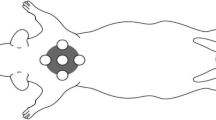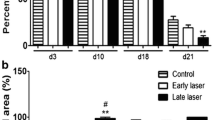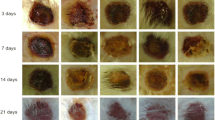Abstract
This study aimed to elucidate the optimum usage parameters of low reactive-level laser therapy (LLLT) in a rat incisional wound model. In Sprague-Dawley rats, surgical wounds of 15-mm length were made in the dorsal thoracic region. They were divided into groups to receive 660-nm diode laser irradiation 24 h after surgery at an energy density of 0 (control), 1, 5, or 10 J/cm2. Tissue sections collected on postoperative day 3 were stained with hematoxylin-eosin and an antibody for ED1 to determine the number of macrophages around the wound. Samples collected on day 7 were stained with hematoxylin-eosin and observed via polarized light microscopy to measure the area occupied by collagen fibers around the wound; day 7 skin specimens were also subjected to mechanical testing to evaluate tensile strength. On postoperative day 3, the numbers of macrophages around the wound were significantly lower in the groups receiving 1 and 5 J/cm2 irradiation, compared to the control and 10 J/cm2 irradiation groups (p < 0.01). The area occupied by collagen fibers in day 7 was largest in 5 J/cm2 group, followed by 1 J/cm2 group, although this difference was not significant. The day 7 tensile test demonstrated significantly greater rupture strength in healing tissues from 1 and 5 J/cm2 irradiation groups, compared to the control group (p < 0.05). Thus, LLLT with a 660-nm diode laser with energy density of 1 and 5 J/cm2 enhanced wound healing in a rat incisional wound model. However, a higher radiation energy density yielded no significant enhancement.






Similar content being viewed by others
References
Mester E, Gyenes G, Tota JG (1969) Experimentelle Untersuchungen über die Wirkung von Laserstrahlen auf die Wundheilung. Z Exper Chir 2:94–101
Mester E, Spiry T, Szende B, Tota JG (1971) Effect of laser rays on wound healing. Am J Surg 122:532–535
Boschi ES, Leite CE, Saciura VC, Caberlon E, Lunardelli A, Bitencourt S, Melo DA, Oliveira JR (2008) Anti-inflammatory effects of low-level laser therapy (660 nm) in the early phase in carrageenan-induced pleurisy in rat. Lasers Surg Med 40:500–508
de Sousa AP, Paraguassú GM, Silveira NT, de Souza J, Cangussú MC, de Santos JN, Pinheiro AL (2013) Laser and LED phototherapies on angiogenesis. Lasers Med Sci 28:981–987
Maegawa Y, Itoh T, Hosokawa T, Yaegashi K, Nishi M (2000) Effects of near-infrared low-level laser irradiation on microcirculation. Lasers Surg Med 27:427–437
Posten W, Wrone DA, Dover JS, Arndt KA, Silapunt S, Alam M (2005) Low-level laser therapy for wound healing: mechanism and efficacy. Dermatol Surg 31:334–340
Demidova-Rice TN, Salomatina EV, Yaroslavsky AN, Herman IM, Hamblin MR (2007) Low-level light stimulates excisional wound healing in mice. Lasers Surg Med 39:706–715
Walker MD, Rumpf S, Baxter GD, Hirst DG, Lowe AS (2000) Effect of low-intensity laser irradiation (660 nm) on a radiation-impaired wound-healing model in murine skin. Lasers Surg Med 26:41–47
Atabey A, Karademir S, Atabey N, Barutçu A (1995) The effects of the helium neon laser on wound healing in rabbits and on human skin fibroblasts in vitro. Eur J Plast Surg 18:99–102
Medrado AR, Pugliese LS, Reis SR, Andrade ZA (2003) Influence of low level laser therapy on wound healing and its biological action upon myofibroblasts. Lasers Surg Med 32:239–244
Yasukawa A, Ohrui H, Koyama Y, Nagai M, Takakuda K (2007) The effect of low reactive-level laser therapy (LLLT) with helium-neon laser on operative wound healing in a rat model. J Vet Med Sci 69:799–806
Hess CT (2012) Clinical guide to skin and wound care. Lippincott Williams & Wilkins, Philadelphia
Singer AJ, Clark RA (1999) Cutaneous wound healing. N Engl J Med 341:738–746
Martin P (1997) Wound healing—aiming for perfect skin regeneration. Science 276:75–81
Haroon ZA, Raleigh JA, Greenberg CS, Dewhirst MW (2000) Early wound healing exhibits cytokine surge without evidence of hypoxia. Ann Surg 231:137–147
Juniantito V, Izawa T, Yamamoto E, Murai F, Kuwamura M, Yamate J (2011) Heterogeneity of macrophage populations and expression of galectin-3 in cutaneous wound healing in rats. J Comp Pathol 145:378–389
Pallotta RC, Bjordal JM, Frigo L, Leal Junior EC, Teixeira S, Marcos RL, Ramos L, Messias Fde M, Lopes-Martins RA (2011) Infrared (810-nm) low-level laser therapy on rat experimental knee inflammation. Lasers Med Sci 27:71–78
Demir H, Balay H, Kirnap M (2004) A comparative study of the effects of electrical stimulation and laser treatment on experimental wound healing in rats. J Rehabil Res Dev 41:147–154
Lubart R, Friedmann H, Peled I, Grossman N (1993) Light effect on fibroblast proliferation. Laser Ther 5:55–57
Liu H, Dang Y, Wang Z, Chai X, Ren Q (2008) Laser induced collagen remodeling: a comparative study in vivo on mouse model. Lasers Surg Med 40:13–19
Akasaka Y, Ono I, Yamashita T, Jimbow K, Ishii T (2004) Basic fibroblast growth factor promotes apoptosis and suppresses granulation tissue formation in acute incisional wounds. J Pathol 203:710–720
Prabhu V, Rao S, Chandra S, Kumar P, Rao L, Guddattu V, Satyamoorthy K, Mahato KK (2012) Spectroscopic and histological evaluation of wound healing progression following low level laser therapy (LLLT). J Biophotonics 5:168–184
Stadler I, Lanzafame RJ, Evens R, Narayan V, Dailey B, Buehner N, Naim JO (2001) 830-nm irradiation increases the wound tensile strength in a diabetic murine model. Lasers Surg Med 28:220–226
Oliveira RA, Matos AF, Barros NR, Fernandes GA, Lima AC, Nicolau RA (2013) Low-intensity laser therapy and led (light emitting diode) therapy in mechanical resistance of Rattus norvegicus chest incision with implant of steel wire for sternal suture. Braz J Biomed Eng 29:166–174
Wilgus TA (2008) Immune cells in the healing skin wound: influential players at each stage of repair. Pharmacol Res 58:112–116
Acknowledgments
None of the authors have received direct or indirect benefits as a result of this work.
Author information
Authors and Affiliations
Corresponding author
Rights and permissions
About this article
Cite this article
Suzuki, R., Takakuda, K. Wound healing efficacy of a 660-nm diode laser in a rat incisional wound model. Lasers Med Sci 31, 1683–1689 (2016). https://doi.org/10.1007/s10103-016-2038-0
Received:
Accepted:
Published:
Issue Date:
DOI: https://doi.org/10.1007/s10103-016-2038-0




